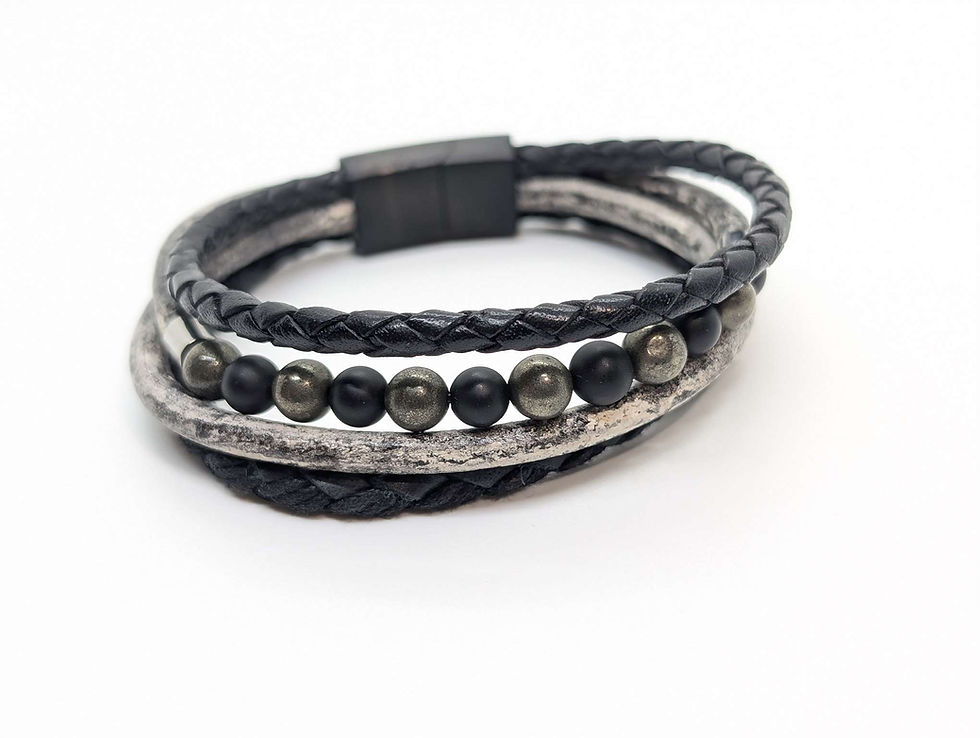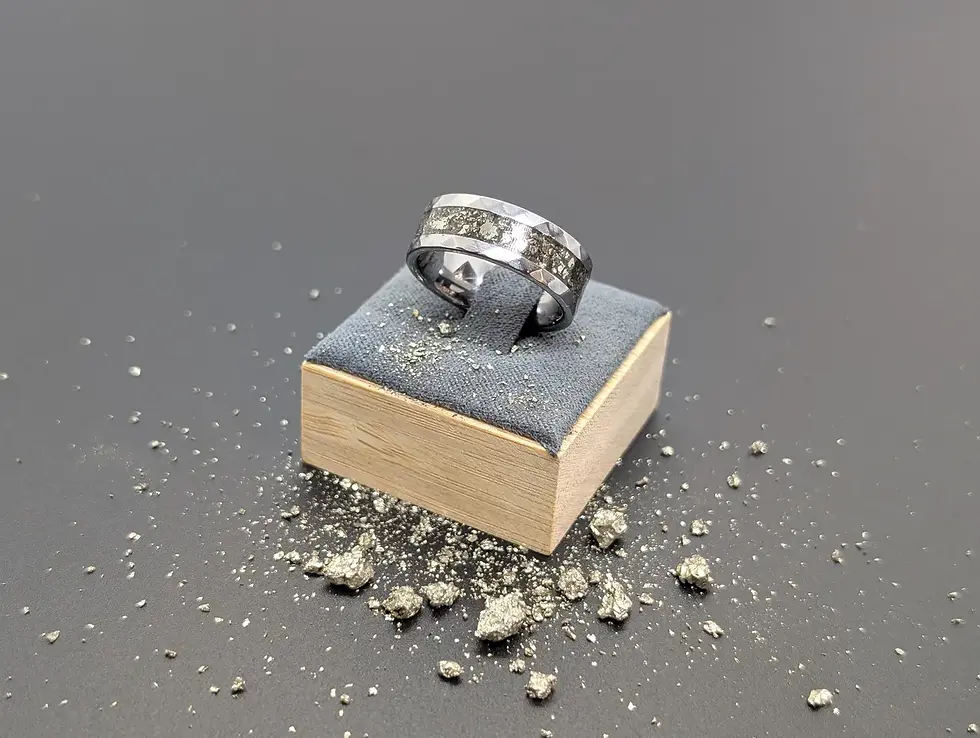

Pyrite: The stone that shines like gold
Discover pyrite , this fascinating stone with golden reflections that has captivated humanity for centuries. Nicknamed " fool's gold " for its resemblance to the precious metal , pyrite is much more than a simple imitation. In lithotherapy , it is recognized for its powerful energetic properties , stimulating the intellect, promoting self-confidence and bringing strength and vitality.
Mineralogy of Pyrite
Pyrite , often mistaken for gold because of its brilliance and color, is a fascinating mineral that turns out to be much more complex than it seems. Let's discover its mineralogical secrets:
Mineralogical characteristics:
Chemical composition: Iron disulfide (FeS2)
Hardness: 6 to 6.5 on the Mohs scale (relatively scratch resistant)
Density: 4.9 to 5.2 g/cm³
Crystal system: Cubic (frequent geometric shapes: cubes, octahedra, pyritohedra)
Color: Brass yellow
Shine: Intense metallic
Cleavage: Imperfect (breaks irregularly)
Fracture: Conchoidal (curved and smooth fracture reminiscent of the inside of a shell)
Special properties: Sensitive to moisture and may oxidize over time.
Formation and deposits
Types of training:
Magmatic: Direct crystallization from sulfur-rich magmas. Present in certain igneous rocks (granites, gabbros).
Hydrothermal: Deposition by hydrothermal fluids circulating in cracks in rocks. Common in metalliferous veins.
Sedimentary: Formed in oxygen-poor marine environments by bacterial activity. Present in certain sedimentary rocks (black shales).
Metamorphic: Formation or recrystallization during the transformation of rocks under the effect of heat and pressure.
Important deposits:
Spain: Navajún (La Rioja) - Exceptional cubic crystals.
Italy: Elba Island - Pyrites associated with hematite and quartz .
Peru: Peruvian Andes - Significant deposits exploited.
United States: Colorado, Illinois, Missouri.
Other countries: Pyrite is found in many other countries, including France, Germany, Russia, Canada, etc.
Varieties of pyrite
Pyrite crystals: Cubes, octahedrons, pyritohedrons.
Massive pyrite: Compact, granular aggregates.
Pyrite nodules: Spherical or ovoid masses.
Raspberry pyrite: Aggregates of spherical microcrystals.
" Marcasite " (actually pyrite): Forms a variety of pyrite with an orthorhombic crystal structure . It is often found in radiating formations or in aggregates resembling cockscombs.


Pyrite in History: A " Fool's Gold " with Multiple Uses
The history of pyrite is closely linked to that of humanity. Since ancient times, this stone has fascinated with its metallic luster and golden color , arousing curiosity, admiration, and sometimes even... disappointment!
Fool's Gold: A Deceptive Resemblance
Its nickname " fool's gold " comes from its striking resemblance to gold. During the great explorations and gold rushes, many were deceived by its appearance, mistaking this worthless stone for the precious metal. This confusion gave rise to numerous anecdotes and legends, helping to forge pyrite 's reputation.
Varied Uses Across the Ages
Prehistory: Traces of pyrite use date back to the Paleolithic period. Our ancestors used it to produce fire by striking it against flint , a technique that lasted for millennia.
Antiquity: Ancient civilizations, such as the Egyptians, Greeks, and Romans, were familiar with pyrite . They used it in particular for making jewelry , amulets, and decorative objects. The Incas, for their part, polished large slabs of pyrite to make mirrors.
Middle Ages and Renaissance: Pyrite continued to be used to light fires , particularly in primitive firearms. It was also used in traditional medicine for its supposed healing properties .
Industrial era : Pyrite was an important source of sulfur for the production of sulfuric acid , a chemical compound essential in many industrial processes.
Myths and Legends
-
Beyond its practical uses, pyrite has also fueled imagination and beliefs . In some cultures, it was considered a protective stone , capable of repelling negative energies and dangers . It was also believed to have the power to stimulate the intellect , self-confidence and inner strength.
Pyrite : Benefits and virtues for the body and mind
Root Chakra, Solar Plexus.
Cognitive and mental improvement
Pyrite stimulates intellectual faculties , concentration and memory.
It encourages logical and rational thinking, making it a valuable ally for students and people in intellectual professions.
It also helps in making decisions and taking action .
Emotional balance and well-being
A stone of self-confidence, pyrite helps to overcome shyness and assert one's personality.
It also promotes introspection and self-knowledge by helping to bring to light emotional blockages and repetitive patterns.
Physical support and vitality
Pyrite is known to strengthen the respiratory system and help fight lung conditions.
It can also relieve pain and speed up the healing of burns.
Tips for using pyrite
To stimulate thinking and concentration , hold a pyrite in your hand for a few minutes.
For better grounding and spiritual elevation, place a pyrite under your feet during your meditation sessions.
Wear a pyrite pendant to strengthen your respiratory tract and benefit from its positive energy every day.
Avoid soaking your pyrite in water to preserve its shine.
Pyrite is not suitable for preparing elixirs.
Note: Lithotherapy does not replace medical advice.






















